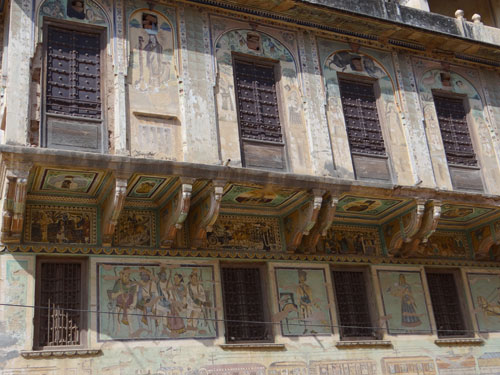|
|
The South
Asian Life & Times - SALT |
|
|||
|
Contents Cover Story
Dr
Karan Singh's
59th National Film
'Rang'
Colors of
Mike Pandey wins
SaMaPa Music
|
|
||||
|
Fading Grandeur of
The arid,
barren, dusty and painted region of Shekhawati spreads across three
districts of Rajasthan – Jhunjhunu,
Sikar, and Churu. There are over 2,000 painted havelis (mansions)
spread across the small desert towns of the region – most are abandoned and
decaying but still stunning in their fading grandeur. SALT brings this
exclusive feature on the havelis in the Shekhawati towns of Nawalgarh,
Fatehpur, Mandawa and also the less frequented, but far more arresting and
engaging towns of Ramgarh and Lakshmangarh – that abound in these structural
and architectural gems, and which may not be amongst us for long. These
havelis have fallen to time and neglect.
The Shekhawati region, known as the open-air art
gallery of Rajasthan, lies in the roughly triangular area between Delhi,
Jaipur, and Bikaner, and encompasses the districts of Jhunjhunu, Sikar, and
Churu. A drive through this vast, barren, almost surreal landscape, dotted
with khejri trees and their outstretched branches, can be oddly hypnotising.
The wide, open uninhabited spaces seem light years away from the madness of
Indian cities. Shekhawati is Rajasthan’s best-kept secret – there are over
2,000 painted havelis (mansions) dispersed in its small desert towns - most
were built in the mid and late 19th century by members of the
rich Marwari community of the area.
Some
of these heritage mansions are even older. The exterior and interiors of
these buildings were richly decorated with figurative and floral art in
bright colours. Less was not more at the time. In fact more was not enough –
as is evident in all havelis, barring one exception in Lakshmangarh that had
a uniquely different style of decoration, and a refreshingly different
palette of colours – but it was in ruins!
|
|||||
|
Copyright © 2000 - 2012 [the-south-asian.com]. Intellectual Property. All rights reserved. |
|||||
